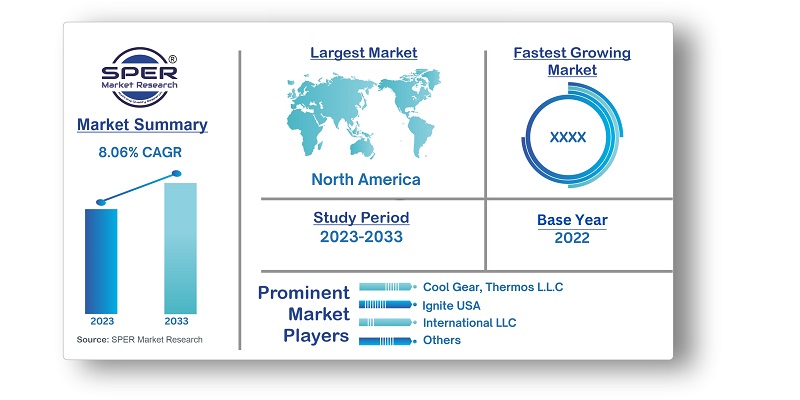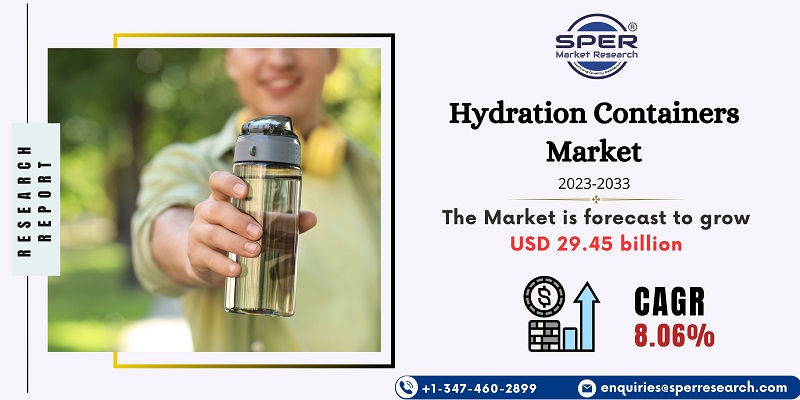
Hydration Containers Market Growth, Size, Trends, Revenue, Demand, Share and Future Outlook
Hydration Containers Market Size- By Type, By Materials, By Application, By End User- Regional Outlook, Competitive Strategies and Segment Forecast to 2033
| Published: Dec-2023 | Report ID: PACK2329 | Pages: 1 - 204 | Formats*: |
| Category : Packaging | |||
- 2022: Hidrate Inc., a prominent producer of smart bottles, introduced Hidrate Spark 3, an advanced model of the smart bottle. Users of Hidrate Spark 3 must install the free Hidrate app on their smartphones. The app will automatically display the amount of water left in the bottle when that person drinks from it.
- 2021: In collaboration with Starbucks, Brita is launching a new range of reusable water bottles with the Starbucks name and logo. The bottles are long-lasting and robust, constructed from materials free of BPA.
 Market Opportunities and Challenges
Market Opportunities and Challenges
| Report Metric | Details |
| Market size available for years | 2019-2033 |
| Base year considered | 2022 |
| Forecast period | 2023-2033 |
| Segments covered | By Type, By Material, By Application By End User |
| Regions covered | North America, Asia-Pacific, Latin America, Middle East & Africa and Europe |
| Companies Covered | AQUASANA INC, ZeJiang Haers Vaccum Containers Co. Ltd, Lock&Lock Co. Ltd, Nalge Nunc International Corp., Cool Gear, Thermos L.L.C., Hydro Flask, Bubba Brands Inc., Ignite USA, International LLC, Tupperware Brands Corporation, Klean Kanteen Inc., Brita GmbH, |
- Consumers
- Corporate and Promotional Buyers
- Environmental Organizations
- Government and Regulatory Bodies
- Health and Fitness Industry
- Manufacturers and Suppliers
- Outdoor and Adventure Enthusiasts
- Retailers
- Others
| By Type: |
|
| By Material: |
|
| By Application: |
|
| By End User: |
|
- Global Hydration Containers Market Size (FY’2023-FY’2033)
- Overview of Global Hydration Containers Market
- Segmentation of Global Hydration Containers Market By Type (Cans, Collapsible, Infusers, Mason Jars, Shakers, Tumblers, Water Bottles )
- Segmentation of Global Hydration Containers Market By Material (Glass, Metal, Plastic, Silicone)
- Segmentation of Global Hydration Containers Market By Application (Department Store, Hyper/Supermarket, Independent Stores)
- Segmentation of Global Hydration Containers Market By End User (Commercial, Residential)
- Statistical Snap of Global Hydration Containers Market
- Expansion Analysis of Global Hydration Containers Market
- Problems and Obstacles in Global Hydration Containers Market
- Competitive Landscape in the Global Hydration Containers Market
- Impact of COVID-19 and Demonetization on Global Hydration Containers Market
- Details on Current Investment in Global Hydration Containers Market
- Competitive Analysis of Global Hydration Containers Market
- Prominent Players in the Global Hydration Containers Market
- SWOT Analysis of Global Hydration Containers Market
- Global Hydration Containers Market Future Outlook and Projections (FY’2023-FY’2033)
- Recommendations from Analyst
1.1. Scope of the report1.2. Market segment analysis
2.1. Research data source
2.1.1. Secondary Data2.1.2. Primary Data2.1.3. SPER’s internal database2.1.4. Premium insight from KOL’s
2.2. Market size estimation
2.2.1. Top-down and Bottom-up approach
2.3. Data triangulation
4.1. Driver, Restraint, Opportunity and Challenges analysis
4.1.1. Drivers4.1.2. Restraints4.1.3. Opportunities4.1.4. Challenges
4.2. COVID-19 Impacts of the Global Hydration Containers Market
5.1. SWOT Analysis
5.1.1. Strengths5.1.2. Weaknesses5.1.3. Opportunities5.1.4. Threats
5.2. PESTEL Analysis
5.2.1. Political Landscape5.2.2. Economic Landscape5.2.3. Social Landscape5.2.4. Technological Landscape5.2.5. Environmental Landscape5.2.6. Legal Landscape
5.3. PORTER’s Five Forces
5.3.1. Bargaining power of suppliers5.3.2. Bargaining power of buyers5.3.3. Threat of Substitute5.3.4. Threat of new entrant5.3.5. Competitive rivalry
5.4. Heat Map Analysis
6.1. Global Hydration Containers Market Manufacturing Base Distribution, Sales Area, Product Type6.2. Mergers & Acquisitions, Partnerships, Product Launch, and Collaboration in Global Hydration Containers Market
7.1. Global Hydration Containers Market Value Share and Forecast, By Type, 2023-20337.2. Cans7.3. Collapsible7.4. Infusers7.5. Mason Jars7.6. Shakers7.7. Tumblers7.8. Water Bottles
8.1. Global Hydration Containers Market Value Share and Forecast, By Material, 2023-20338.2. Glass8.3. Metal8.4. Plastic8.5. Silicone
9.1. Global Hydration Containers Market Value Share and Forecast, By Application, 2023-20339.2. Department Stores9.3. Hyper/Supermarket9.4. Independent Stores9.5. Online Sales
9.6. Speciality Stores
10.1. Global Hydration Containers Market Value Share and Forecast, By End user, 2023-2033
10.2. Adults10.3. Athletes10.4. Children10.5. Travelers
11.1. Global Hydration Containers Market Size and Market Share
12.1. Global Hydration Containers Market Size and Market Share By Type (2019-2026)12.2. Global Hydration Containers Market Size and Market Share By Type (2027-2033)
13.1. Global Hydration Containers Market Size and Market Share By Material (2019-2026)13.2. Global Hydration Containers Market Size and Market Share By Material (2027-2033)
14.1. Global Hydration Containers Market Size and Market Share By Application (2019-2026)14.2. Global Hydration Containers Market Size and Market Share By Application (2027-2033)
15.1. Global Hydration Containers Market Size and Market Share By End User (2019-2026)15.2. Global Hydration Containers Market Size and Market Share By End User (2027-2033)
16.1. Global Hydration Containers Market Size and Market Share By Region (2019-2026)16.2. Global Hydration Containers Market Size and Market Share By Region (2027-2033)
16.3. Asia-Pacific
16.3.1. Australia16.3.2. China16.3.3. India16.3.4. Japan16.3.5. South Korea16.3.6. Rest of Asia-Pacific
16.4. Europe
16.4.1. France
16.4.2. Germany16.4.3. Italy16.4.4. Spain16.4.5. United Kingdom16.4.6. Rest of Europe
16.5. Middle East and Africa
16.5.1. Kingdom of Saudi Arabia16.5.2. United Arab Emirates16.5.3. Rest of Middle East & Africa
16.6. North America
16.6.1. Canada16.6.2. Mexico16.6.3. United States
16.7. Latin America
16.7.1. Argentina16.7.2. Brazil16.7.3. Rest of Latin America
17.1. Aquasana Inc.
17.1.1. Company details17.1.2. Financial outlook17.1.3. Product summary17.1.4. Recent developments
17.2. Bubba Brands Inc.
17.2.1. Company details17.2.2. Financial outlook17.2.3. Product summary17.2.4. Recent developments
17.3. Brita GmbH
17.3.1. Company details17.3.2. Financial outlook17.3.3. Product summary17.3.4. Recent developments
17.4. Cool Gear
17.4.1. Company details17.4.2. Financial outlook17.4.3. Product summary17.4.4. Recent developments
17.5. Ignite USA
17.5.1. Company details17.5.2. Financial outlook17.5.3. Product summary17.5.4. Recent developments
17.6. Klean Kanteen Inc.
17.6.1. Company details17.6.2. Financial outlook17.6.3. Product summary17.6.4. Recent developments
17.7. Nalge Nunc International Corp.
17.7.1. Company details17.7.2. Financial outlook17.7.3. Product summary17.7.4. Recent developments
17.8. Lock & Lock Co.
17.8.1. Company details17.8.2. Financial outlook17.8.3. Product summary17.8.4. Recent developments
17.9. Tupperware Brands Corporation
17.9.1. Company details17.9.2. Financial outlook17.9.3. Product summary
17.9.4. Recent developments
17.10. Zejiang Haers Vaccum Containers Co. Ltd
17.10.1. Company details17.10.2. Financial outlook17.10.3. Product summary17.10.4. Recent developments
17.11. Others
SPER Market Research’s methodology uses great emphasis on primary research to ensure that the market intelligence insights are up to date, reliable and accurate. Primary interviews are done with players involved in each phase of a supply chain to analyze the market forecasting. The secondary research method is used to help you fully understand how the future markets and the spending patterns look likes.
The report is based on in-depth qualitative and quantitative analysis of the Product Market. The quantitative analysis involves the application of various projection and sampling techniques. The qualitative analysis involves primary interviews, surveys, and vendor briefings. The data gathered as a result of these processes are validated through experts opinion. Our research methodology entails an ideal mixture of primary and secondary initiatives.



Frequently Asked Questions About This Report
PLACE AN ORDER
Year End Discount
Sample Report
Pre-Purchase Inquiry
NEED CUSTOMIZATION?
Request CustomizationCALL OR EMAIL US
100% Secure Payment






Related Reports
Our Global Clients
Our data-driven insights have influenced the strategy of 200+ reputed companies across the globe.






















